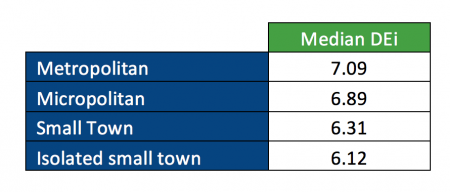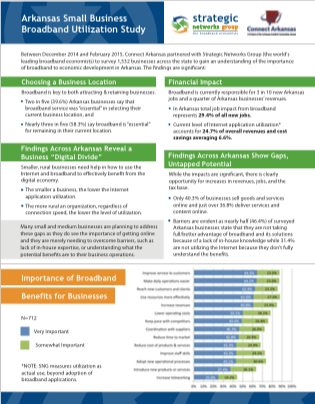Connect Arkansas Looks to Drive Economic Impact, Small Business Growth
Connect Arkansas  is a private nonprofit dedicated to increasing high-speed Internet implementation and utilization throughout Arkansas. As a project of the Arkansas Capital Corporation Group, Connect Arkansas is now taking significant steps in partnership with SNG to drive broadband utilization amongst its businesses.
is a private nonprofit dedicated to increasing high-speed Internet implementation and utilization throughout Arkansas. As a project of the Arkansas Capital Corporation Group, Connect Arkansas is now taking significant steps in partnership with SNG to drive broadband utilization amongst its businesses.
As actual Internet utilization (beyond infrastructure and adoption) is critical for business growth and prosperity, Connect Arkansas commissioned SNG to conduct a statewide eSolutions Benchmarking Study amongst small-to-medium sized businesses.
This study will help Connect Arkansas better understand the gaps and barriers to utilization as well as the current financial impacts of broadband and its applications, including:
- In Arkansas, total job impact from broadband represents 29.4% of all new jobs.
- Current level of Internet application utilization accounts for 24.7% of overall revenues and cost savings averaging 6.6%.
Also fascinating and consistent with SNG’s findings across the United States, there is a digital divide in utilization amongst smaller and rural businesses. The smaller a business, the lower the Internet application utilization. The same goes for the more rural an organization is (see accompanying article). This is especially troublesome given the fact that more than 90% of Arkansas’ (and America’s) are small businesses.
Arkansas businesses realize there is more they can and should be doing online. Nearly half (46.4%) say that they are not taking full/better advantage of broadband and its solutions because of a lack of in-house knowledge. Nearly a third (31.4%) are not utilizing the Internet because they don’t fully understand the benefits.
So how do we help small businesses better utilize broadband and its applications to increase revenues, jobs, and the tax base?
Connect Arkansas is currently running a pilot of its Small Business Growth Program with 100 Arkansas businesses which includes coaching, online tools, and most importantly a utilization scorecard. This scorecard compares the current level of Internet use to other organizations of similar size in the same industry. It identifies the top three Internet tools and strategies to drive new revenues and/or cost savings for this particular business.
The recommendations provided to the 100 small businesses in Arkansas averaged a financial impact (revenues and cost savings) of $225,000 per company. If all of these 100 businesses undertake these recommendations, the overall impacts would be $22.5 million aggregate positive financial impacts to the businesses. This also equates to a potential job growth of 100 direct and 250 total jobs.
Moving forward Arkansas will have the ability to drive their economy through the better utilization of broadband among all businesses who participated in the benchmarking study, carrying with it a potential of $202 million in financial impacts across the State, 900 direct and 2,250 total jobs amongst approximately 1,000 small businesses.
Infrastructure is critical and gigafying… everything… is certainly the sizzle. Utilization is the steak and we’d love to help you “feed” your small businesses the sme way we’re helping Arkansas and others across the globe.
You can find SNG’s Arkansas findings here >>
There is a high degree of awareness of how differences in Internet connectivity contribute to the “digital divide” experienced by many, if not most, rural areas. Less is understood about a very real divide that exists from (a lack of) utilization. That’s right, just as important as “speed” is how much businesses and non-commercial organizations utilize the Internet.
Using the data SNG has collected in numerous states between 2012 and February 2015, we can actually quantify this digital divide. Just as significantly, we can identify the types of organizations (industry, size, rural/urban, etc.) that are experiencing the greatest gap in utilization. To quantify utilization, SNG has developed a means to measure utilization we call the Digital Economy index (DEi) that is a reflection of how many Internet processes or applications an organization uses. We measure use of 17 applications on a ten-point scale (ten being best) to develop the DEi (e.g. an organization using 8 of 17 applications would have a DEi score of 4.7).
 Collecting data in numerous states, each with rural and urban components, SNG has uncovered the digital divide that exists based largely on the size of the community businesses are located. The table on the right shows that the more urban a community, the higher the DEi score. Regardless of speed available, rural communities are utilizing the Internet and its applications at a lower rate largely because in rural areas there is less knowledge transfer amongst peers and less of a market for specialized technical services.
Collecting data in numerous states, each with rural and urban components, SNG has uncovered the digital divide that exists based largely on the size of the community businesses are located. The table on the right shows that the more urban a community, the higher the DEi score. Regardless of speed available, rural communities are utilizing the Internet and its applications at a lower rate largely because in rural areas there is less knowledge transfer amongst peers and less of a market for specialized technical services.
Beyond the notable gap in Internet utilization between rural and urban areas, SNG’s research also reveals sectors and types of organizations that suffer most from this digital divide. This is consistent with our findings that rural communities have far less local resources to support businesses looking to better utilize broadband applications.
For small towns & isolated small towns (in essence, the census terms for “rural”), local governments have the largest utilization gap compared to their metropolitan peers: with a DEi of 5.24 compared to 7.17. Libraries also show a notable utilization gaps: metro = 7.23; rural = 6.12). In contrast, K-12 schools of comparable size have very similar DEi scores regardless of how urban or rural they are.
 When examining industry type, it is illuminating to see just how much variance there can be depending on industry. Ironically, one of the biggest utilization gaps is in what might be considered the most advanced sector (Professional and Technical Services) which is large, growing, and well paying but slow to adopt key Internet applications.
When examining industry type, it is illuminating to see just how much variance there can be depending on industry. Ironically, one of the biggest utilization gaps is in what might be considered the most advanced sector (Professional and Technical Services) which is large, growing, and well paying but slow to adopt key Internet applications.
 Larger businesses in rural areas (100 or more employees) still experience a utilization gap to their urban counterparts. Rural businesses with less than 100 employees experience a much larger utilization gap.
Larger businesses in rural areas (100 or more employees) still experience a utilization gap to their urban counterparts. Rural businesses with less than 100 employees experience a much larger utilization gap.
So while fiber, net neutrality, and FCC decisions dominate the news, the success of broadband in driving impacts is dependent on utilization.
This means that providing our rural businesses with the knowledge and support to leverage the Internet is key to maintaining competitiveness. Furthermore, in today’s landscape it is easier to live rural and work globally, as long as rural businesses have access to networks and support systems that help them thrive in the digital economy. Developing local networks and supports is a direct and significant opportunity (as well as challenge) for local business retention and growth. There are ways to achieve this, including SNG’s Small Business Growth Program. We’d love to share with you how this program can drive economic growth in your region.

